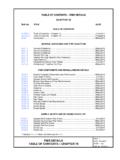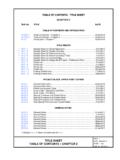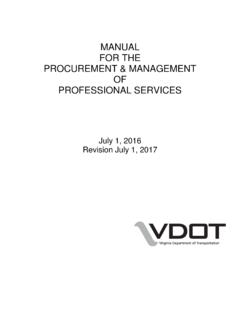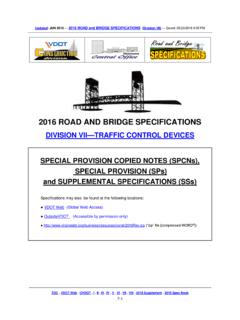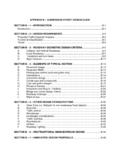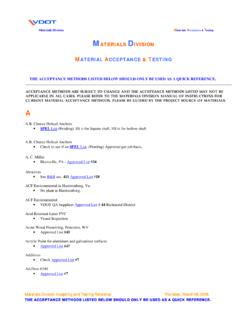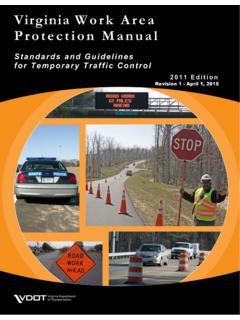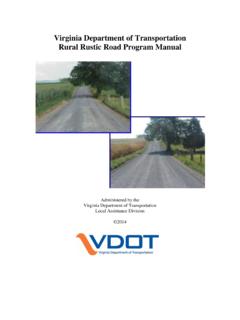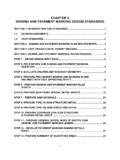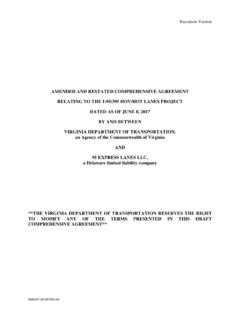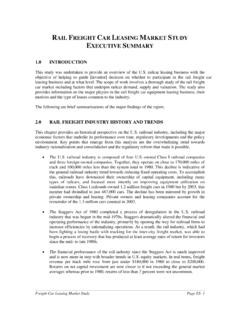Transcription of NEPA Tiering Process - Virginia Department of …
1 I-81 Corridor Improvement Study Tier 1 Draft Environmental Impact Statement 1. nepa Tiering Process Tiering is a staged approach to nepa described in the Council on Environmental Quality's (CEQ's) Regulations for Implementing the Procedural Provisions of the National Environmental Policy Act (40 CFR 1500 1508) and in FHWA's Environmental Impact and Related Procedures (23 CFR 771). Tiering addresses broad programs and issues in initial (Tier 1) or systems level analyses, and analyzes site-specific proposals and impacts in subsequent tier studies. The tiered Process supports decision-making on issues that are ripe for decision and provides a means to preserve those decisions.
2 This Tier 1 Environmental Impact Statement (EIS) is the vehicle for fact-based analyses that supports informed decision-making on corridor-length issues associated with I-81 in Virginia , such as consideration of the use of tolls as a funding source for improvements and consideration of opportunities for separation of trucks and passenger vehicles. The Process Streamlining Agreement Between the Virginia Department of Transportation and the Federal Highway Administration on the Interstate 81 Corridor National Environmental Policy Act Process (see Appendix A) defines the decisions to be made and the approvals to be granted at specific milestones of the tiered environmental Process and defines the study approach, Process , and elements to be included in each stage of the tiered analysis.
3 The Process will consist of a Tier 1 Draft EIS, a Tier 1 Final EIS, and a Tier 1 Record of Decision (ROD) to conclude Tier 1. Upon completion of the Tier 1 study, decisions will be made on: The improvement concepts for highway and rail facilities;. Advancing I-81 as a toll pilot facility under Section 1216(b) of the Transportation Equity Act for the 21st Century (TEA-21);. Projects with independent utility and logical termini to be studied in Tier 2;. The types of Tier 2 nepa document(s);. The location of the corridor for studying alignments in Tier 2; and nepa Tiering Process 1-1.
4 I-81 Corridor Improvement Study Tier 1 Draft Environmental Impact Statement possible purchase of certain right-of-way parcels on a case-by-case basis1. In addition to these decisions, the Tier 1 DEIS documents existing and future needs along the corridor. It is important to note that, for the Tier 1 study, a decision is not being made on a toll rate, but on the improvement concepts to be advanced regardless of toll structure. Different toll rates were studied in conjunction with the Build concepts in order to examine the potential diversions from I-81 that may occur if tolls were implemented.
5 The impact of tolls on the number of lanes needed was also evaluated. The effects of the range of toll scenarios will support informed decision-making on the concepts to be advanced. If a Build concept (or portion of a Build concept) is advanced into Tier 2, the effects of various toll rates would again also be studied in Tier 2 for the individual projects. It is also important to note that current state law allows tolls to be imposed only on trucks. Specifically, the law states that tolls can be imposed on vehicles other than passenger cars, pickup or panel trucks, and motorcycles, as such terms are defined in [of the Code of Virginia ].
6 This study also considers the effects of tolling cars and trucks. Evaluating the impacts of tolls on cars and trucks represents a worst-case scenario with regard to traffic diversion. This Tier 1 Draft EIS identifies transportation conditions along the interstate, identifies a wide range of opportunities for improvements, and evaluates the range of potential effects of conceptual-level improvements on the social, economic, and environmental setting along the entire I-81 corridor in Virginia . Information presented in this Tier 1 Draft EIS was based primarily on available Geographic Information System (GIS) data; other available databases.
7 Interviews with local, state, and federal officials; and limited field surveys. This level of analysis is commensurate with the decisions being made and is at an appropriate level of detail to allow a comparison of the relative differences in the range of costs and potential impacts of the improvement concepts. If, in Tier 1, one or more Build concepts (or portions of Build concepts) are advanced into Tier 2, those concepts would be analyzed in more detail in subsequent Tier 2 nepa documents. This Tier 1 Draft EIS is also the basis for the identification of individual, independent projects.
8 If a Build concept (or portion of a Build concept) is advanced into Tier 2, subsequent Tier 2 nepa documents prepared for these individual projects would address site-specific details, before design and location decisions are made. For example, final decisions on the precise location and configuration of lanes would be made at the conclusion of Tier 2, based on traffic projections or other factors, when detailed information is developed. The effects of various toll rates on the number of lanes to be constructed would 1. While this Tier 1 DEIS does not include any decisions to purchase specific right-of-way parcels, it provides information to support decisions to be made on hardship acquisitions or protective purchases in the future on a case-by-case basis.
9 nepa Tiering Process 1-2. I-81 Corridor Improvement Study Tier 1 Draft Environmental Impact Statement again also be studied in Tier 2 for the individual projects. Compliance with all applicable environmental laws and regulations would occur for each project in Tier 2, if a Build concept (or portion of a Build concept) is advanced into Tier 2. The Tier 1 decisions do not preclude future avoidance and minimization measures as part of Tier 2. Furthermore, if a Build concept (or portion of a Build concept) is advanced into Tier 2, construction of individual projects could not occur until the completion of the subsequent Tier 2 nepa .
10 Documents. The decisions that would be made upon the completion of the Tier 2 studies are: Approval of design features for improvements ( , the typical section) for components identified in Tier 1;. Authority to use federal funds on final design of the improvements;. Authority to acquire right-of-way;. Eligibility for federal funding of construction; and Approval to modify access to I-81. There is a strong public interest in studying rail improvements to divert freight ( , trucks). off of I-81 in Virginia . This interest was widely known before the initiation of the nepa .
